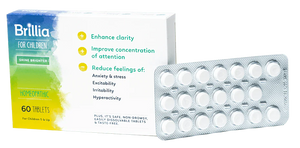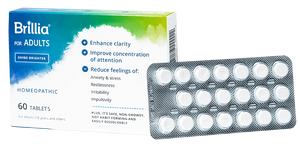Anxiety in children with ADHD is common, affecting an estimated 3 in 10 kids.1 These conditions can also mimic each other with overlapping symptoms like poor sleep and restlessness. Some ADHD medications can make matters worse, exacerbating anxiety or causing it in a previously non-anxious kid.
If you’re looking into ADHD treatments for your child with anxiety, explore the best medications or supplements to reduce symptoms of both conditions.
Understanding the Connection between ADHD and Anxiety in Children
It’s a chicken and egg situation. Which came first: ADHD or anxiety? Findings from a 2022 study suggest there is a bidirectional relationship between the two conditions and that treating one can help the other.2 People with ADHD are also around 50 percent more likely to be diagnosed with an anxiety disorder than people without ADHD.3 The constant feeling of overwhelm and powerlessness a person with ADHD feels in the face of daily stressors can exacerbate anxiety. Not knowing how to self-regulate, a history of getting in trouble at school, and uncertainty about how tasks will play out also play a role.
The Importance of a Comprehensive Treatment Approach
Both ADHD and anxiety are typically treated through medication and/or therapy. But you should also consider the importance of one’s overall health. Ensuring your child is following a nutritious diet, getting enough sleep, limiting their screen time, and making time for mindfulness or relaxation, are all proven ways to reduce symptoms of both anxiety and ADHD. Each child will respond to different strategies in their own unique way, so devising a comprehensive treatment plan is the best way to address their symptoms from all possible angles.
Non-Prescription Medication
When it comes to considering medication for your child, it’s recommended to start with the gentlest, least invasive option available. This allows you to view prescription medications as a last resort after other routes have been explored. It also allows your child to avoid the likelihood of experiencing side effects associated with common ADHD and anxiety medications.
Brillia
Brillia for Children and Teens is a non-prescription homeopathic medication that helps to reduce anxiety, hyperactivity, inattention, and impulsivity without harsh chemicals or harmful side effects.
Its active ingredient consists of antibodies to the brain-specific S100B protein, a key regulator in many different intracellular and extracellular brain processes. Studies have shown that when the S100B protein is out of balance in the body, these brain processes are disrupted, resulting in increased stress, irritability, and anxiety.4 As Brillia helps to regulate the S100B protein, it also normalizes the level of monoamines (dopamine, norepinephrine, serotonin) in different parts of the brain, inducing calmness and focus. These neurotransmitters are the same ones targeted with prescription ADHD and anxiety medications, although Brillia achieves this normalization gently and impactfully without affecting any other systems in the body, causing drowsiness, affecting the appetite, masking the personality, or making anxiety worse.
Unlike most prescription anxiety and ADHD drugs, Brillia’s dosage does not need to be incrementally increased to maintain its efficacy. Your child can start or stop at any time without having to adjust to the medication or struggle with withdrawal symptoms. And if they are already taking medication for ADHD, Brillia can be added to their regimen without worry because there are no contraindications. In fact, many users take Brillia in conjunction with stimulant medications that cause anxiety as a side effect. Brillia can also be used with prescription medication to avoid having to increase the dosage of their current medications (which also increases the likelihood of experiencing anxiety as a side effect). Even more, Brillia is part of a holistic approach called the 5 Pillars. The medication works best when combined with healthy lifestyle habits like proper nutrition, adequate sleep, controlled screen time, and mindfulness, providing a strategic and comprehensive approach to managing anxiety and ADHD.
A Note on Stimulant Medications
Anxiety is a common side effect of stimulant ADHD medications like Adderall® and Ritalin®. In some cases, stimulant medications have been shown to decrease both anxiety and symptoms of ADHD (24 percent in a recent trial) but they are more likely to exacerbate or instigate such symptoms.5 And even when they do reduce anxiety, such related symptoms like social anxiety and panic remain.6
Stimulant medications for ADHD are generally not recommended for kids with anxiety, but when they are prescribed, experts say they should start with a low dosage and go slowly. As mentioned above, stimulant medications can also be taken in combination with non-prescription Brillia to help reduce anxiety as a secondary symptom.
Selective Norepinephrine Reuptake Inhibitors (SNRIs)
SNRIs were originally formulated to treat depression, but they have also been proven to be effective at reducing anxiety symptoms and managing ADHD. The drugs work by increasing levels of serotonin in the brain as well as norepinephrine, neurotransmitters that help regulate mood, improve attention and alertness, and control your body’s “fight-or-flight” response. While SNRIs are non-addictive, the medication may cause side effects like headaches, lack of appetite, nausea, and muscle twitching.
Strattera® (atomoxetine)
Strattera is an SNRI that may help to reduce anxiety while functioning as a non-stimulant ADHD med. Studies indicate this medication causes a statistically significant reduction in both ADHD and anxiety symptoms compared with placebo, though effects may take around eight weeks.7 The most common side effects in children include upset stomach, decreased appetite, nausea, and vomiting, though some suggest dividing the dosage over the course of the day may help.8
Alpha-2 Agonists
Alpha-2 agonists are also considered non-stimulant ADHD medications which are said to have sedating effects. These drugs inhibit the release of norepinephrine, which reduces impulsivity, hyperactivity, as well as heart rate, blood pressure, and attenuation of the sympathetic stress response.9 Some may be sensitive to the side effects of these medications, which include drowsiness, dry mouth, and decreased appetite.
Intuniv® (guanfacine)
Intuniv is a long-acting form of guanfacine, Intuniv was first intended to treat high blood pressure, but it is now prescribed for ADHD. Studies also show that it is well-tolerated in pediatric subjects with generalized anxiety disorder, separation anxiety disorder, and/or social anxiety disorder, helping to protect cognitive performance during stress.10 Potential side effects may include drowsiness, dizziness, headache, irritability, and decreased appetite.
Combination Therapies
A combination therapy in which you pair your ADHD medication with another type of medication or supplement can be a helpful approach in managing anxiety. Sometimes, doctors prescribe stimulants with non-prescription stimulant meds, but you should always consult your doctor first before combining prescription medications or adding a supplement to your child’s regimen. However, if you are considering trying Brillia, you can add it to your regimen without worry because there are no contraindications associated with the medication.
Learn more about how to add Brillia if you are already taking prescription medications.
Simultaneous Use of ADHD Medication with Behavioral Therapy
Another combination therapy to reduce anxiety while taking ADHD medication is to enroll your child in therapy, specifically cognitive behavioral therapy (CBT). This goal-oriented option helps to modify a patient’s negative patterns of thinking and alter the way they feel about themselves and their abilities.
In a study from the University of Buffalo, researchers found that combining behavioral therapy with medication was the “most effective way” to improve the behavior of many ADHD children and help reduce the need for higher doses of the medication.11
Collaborative Efforts: Involving Parents, Doctors and Therapists in Medication Decision-Making Process
Choosing the right medication for your child with ADHD does not have to be a solo mission. Parents are encouraged to work with their doctors and therapists to find the best solutions for their child based on his or her unique needs. In a study published in the journal Pediatrics, researchers found that using a “collaborative care” model, in which a “care manager” serves as a liaison between parents and pediatricians, was proven more effective at treating ADHD in children than a standard pediatrician-centered model.12
Finding a community can also help give you and your child support. The Brillia community is one accessible place where you can ask questions and browse tips from other parents on how to tackle anxiety and attention challenges with your loved ones.
Find more resources on managing anxiety and ADHD at the Brillia(nce) Resource Center.
 A whole bunch of support right in your inbox.
A whole bunch of support right in your inbox.







